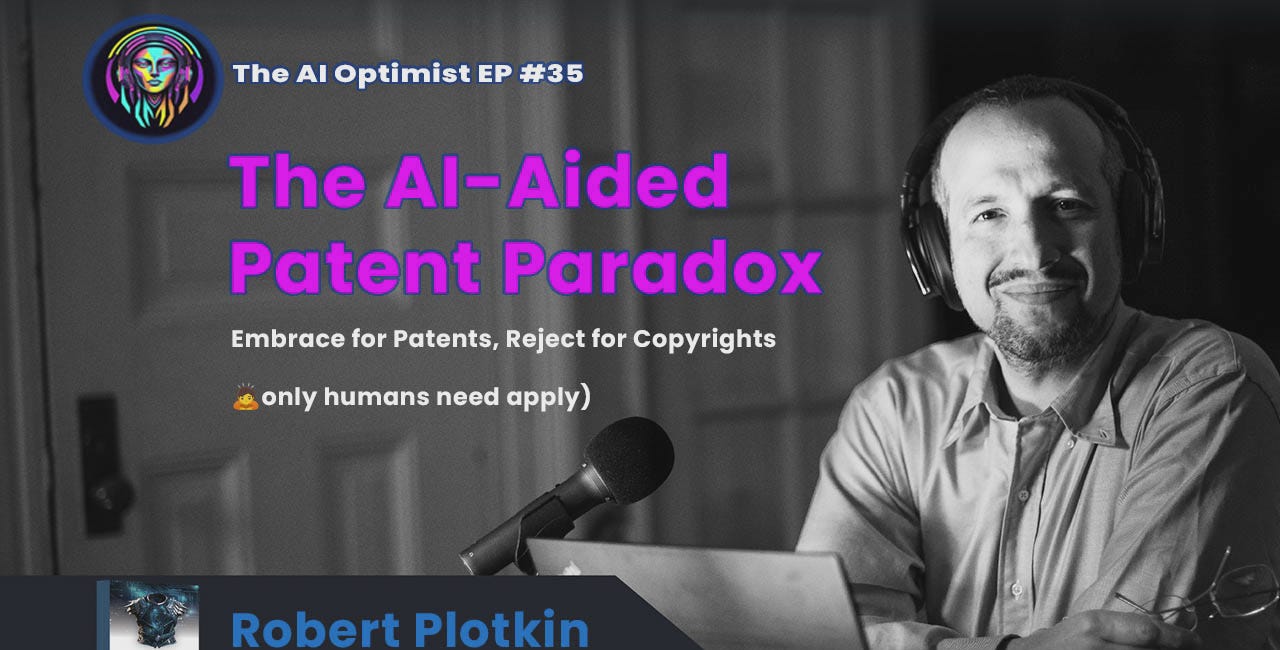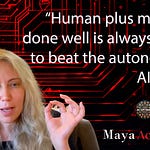Instead of upskilling - a detached vague term scaring people about jobs - let’s future forge your career with this episode.
Replacing AI uprising fears and billion-dollar jargon, meet 3 active AI practitioners, each in their own unique way showing how AI works for you.
We're talking GenAI writing insights that crank out killer content, untangling the legal IP maze of AI patents, and the trippy world of AI role-play apps (for sales training, not Black Mirror, way less creepy).
Join our Adepts: a dynamic content strategist, an IP attorney with laser focus, and an AI Leads pro who breathes custom qualifying.
We'll show you how AI can take your business (and maybe your pipeline) to the next level.
Buckle up, it's gonna be a profitable ride.
Episode #36 Playlist
00:00 Your first GenAI paragraph - delete it!
01:14 Intro to 3 AI Adepts
02:25 AI Content Writing Mini Class
08:40 AI Licensing and Robert Plotkin's MIND Process
06:22 No Tech Differentiation between AI companies??
14:08 AI Role Play Apps - Sales Training
1. AI Content Writing Mini Class with Jessica Mehring
We talk about the weakness of most first paragraphs in writing, including AI, and how to adapt.
2. Licensing AI and IP for Growth with Robert Plotkin,
where AI patent attorney Plotkin shares how he uses the MIND process to build patentable business models that thrive.
3. AI Role Play Apps - Training by Doing with Jonathan Khorsandi of DIWY.edu
CEO Khorsandi takes us through a sales training app called Human Linker, and how it uses psychology and technology to prepare sales people to customize outreach using AI role playing.
1. Revitalize AI Writing:
AI Content Strategies That Captivate from the First Paragraph
Content Adept: Jessica Mehring of Horizon Peak Consulting uses AI to Challenge Thinking
“I help enterprise technology startups and AI-first technology companies create higher performing marketing campaigns.
”Happily ever after' is where innovation goes to die. 'Happy for now' is where hope and opportunity live. Uncover the right stories, tell those stories better, and continuously evolve them."
In my 20+ years working alongside B2B technology companies around the globe, I've seen firsthand how their solutions make everyday work-life better for the employees and leaders who use them.
But no matter how brilliant your technology solution is, if you can’t connect with your target audience human-to-human, they won't see how it fits into the context of their own lives.
The secret to growing revenue faster and more reliably today isn't more automation -- it's making a human connection. Putting conversation before conversion. This is the key to more effective marketing and sales enablement, a better customer experience, and higher converting campaigns.
At Horizon Peak Consulting, I help enterprise and AI-first technology companies produce higher-performing content and copy while also driving a more meaningful customer experience.”
Jessica shares valuable advice for writers to combat "throat clearing" – the tendency to bury the lede (which means pushing down the interesting parts and keeping the boring language on top).
She recommends writing the introduction last or deleting the first paragraph to get straight to the point.
Mehring also discusses her process of creating customer profiles by mining language from various sources, aiming to connect with customers using their own vocabulary.
🌊 Let’s Start Using AI to Challenge Our Thinking: Beyond the Tsunami of AI Content Crap
Looking around at GenAI, many are adding to the tsunami of AI content crap. Because they are trying to let ChatGPT lead the way, and act like it’s a search engine! Step into a mini-class with senior content conversion writer Jessica Mehring and Declan take you beyond the surface and into creating actionable content.
I. Using AI to Challenge Thinking
Jessica shares how she writes first and then uses ChatGPT to summarize, expand, or critique her work.
Writing first helps her identify blind spots and logical gaps to improve vocabulary/phrasing and find new angles she hadn’t considered.
Jessica uses AI to challenge her thought processes and improve her writing, not to replace writers who work with her company.
She uses it for analogies, creative words, and testing ideas.
The key is using AI as a “co-pilot” to augment your skills, not replace them. Please don’t rely on it solely for writing.
II. Limitations of AI Content Creation
Early search results and AI content show “language homogeny,” resulting in standardized, repetitive phrasing and ideas.
Language homogeny refers to the dominance of a single language within a community, often excluding other languages.
While language homogeny makes communication more accessible, it risks losing linguistic and cultural diversity.
Poor use of AI may create a generic language devoid of human creativity while helping those needing more writing skills to find new outlets for their voices.
AI cannot replicate the human experience, and nuanced opinions arise from lived experiences.
Jessica cites her research into what people think about ChatGPT, including the mistaken assumption that it is a search engine.
ChatGPT needs more credibility and a variety of choices than the current search currently provides. Instead, we get a prediction based on the prompt and the questions we ask.
It is essential to ask the right questions, find answers by probing ChatGPT, and push it beyond simple responses.
Understanding that ChatGPT may provide incorrect answers makes checking sources critical.
2. AI Patent Law Insights & The MIND Process
AI Patent Adept Robert Plotkin, with backgrounds in computer science and a attorney, is a leading voice in the field of patent law and AI.
Robert Plotkin, a software and AI patent attorney, explains his MIND process for developing customized intellectual property strategies based on a company's technology and business goals.
He provides an example of patenting a new method for training neural networks, which could be valuable for different businesses beyond the initial commercialized product.
Plotkin also highlights the potential value of data as an intellectual property asset.
The AI-Aided Patent Paradox: Embrace for Patents, Reject for Copyrights 🙇only humans)
Listen on Apple || Spotify || YouTube “An AI system does not have desires, aspirations, or needs. It won't choose to invent...nor will it be demotivated if its name doesn't appear on a patent.” - Robert Plotkin It's time to bridge the intersection of AI, creativity, and the law with Robert Plotkin, an AI legal pioneer who is exploring how AI is reshaping …
His latest, AI Armor, for AI entrepreneurs aiming to protect and enhance their ventures through intellectual property (IP) for driving growth, innovation, and market success.
The MIND process, as detailed by Robert Plotkin, offers a strategic framework designed to optimize intellectual property (IP) management, enabling startups and entrepreneurs to effectively harness their innovation for competitive advantage.
Here's how they can leverage the MIND process:
Map: Assessing the IP Landscape
Startups begin by mapping the current state of their intellectual property and the broader IP landscape in their industry. This involves identifying all potential IP assets, including patents, trade secrets, and trademarks.
Identify: Pinpointing Key IP Assets
Once the landscape is mapped, the next step is to identify which innovations or aspects of the business model are critical to the company's success and should be protected.
Navigate: Developing a Tailored IP Strategy
With a clear understanding of key IP assets, startups navigate the complex world of IP protection by developing a strategy tailored to their specific goals and resources. This includes deciding which innovations to patent, which to protect as trade secrets, and how to manage trademarks effectively.
Drive: Executing and Evolving the IP Strategy
The final step is to drive the IP strategy forward through proactive management and execution. This includes filing for patents, securing trademarks, implementing measures to protect trade secrets, and continuously monitoring the IP landscape for new opportunities or threats
By following the MIND process, startups and entrepreneurs can not only protect their innovations but also use their IP assets as a strategic tool to drive growth, deter competition, and attract investment. It encourages a proactive approach to IP management, where intellectual property becomes a cornerstone of the business strategy, rather than an afterthought.
United States Patent and Trademark Office (USPTO) does not allow AI systems to be listed as inventors on patent applications.
Specific cases are testing the boundaries of AI's role in the patenting process.
And copyrights as well, where AI’s recognition as a creator is being challenged.
A recent case involves the AI system named DABUS ("Device for the Autonomous Bootstrapping of Unified Sentience"), which applied as the inventor of two patent applications.
First created 30 years ago, this living AI project is claiming copyrights for its work, which are limited to humans only.
Through the efforts of its inventor, Stephen Thaler, he is trying to getting the courts to recognize AI as a creator of its own work.
“to complicate the issues presented by devoting a substantial portion of his briefing to the viability of various legal theories under which a copyright in the computer’s work would transfer to him, as the computer’s owner; for example, by operation of common law property principles or the work-for-hire doctrine.” United States District Court for the District of Columbia ruling
Thaler lost because he argued about who gets the copyright, not why it should be granted without a human author. Once again, no human authorship, no copyright.
For centuries, authorship in copyright has meant human authorship. The old and current copyright rules won’t protect anything not primarily created by a human being.
And it is not a simple case of people vs. machines, patents were created in 1624 to encourage people to invent and be protected, and rewarded, for their genius
Next came the patent laws. These began in England in 1624, and in this country with the adoption of our Constitution. Before then any man [might] instantly use what another man had invented, so that the inventor had no special advantage from his own invention. The patent system changed this, secured to the inventor for a limited time exclusive use of his inventions, and thereby added the fuel of interest to the fire of genius in the discovery and production of new and useful things.
Proving AI-generated content relies on a human being, as the author, is almost impossible.
The USPTO, along with other international patent offices, reject these applications on the grounds that the current legal framework requires inventors to be humans.
The USPTO's decision is based on the interpretation that the patent laws are written with the presumption that inventors are natural persons.
The USPTO clarifies its position through a public consultation process, seeking opinions on whether AI systems should be allowed to be credited as inventors on patent applications.
The feedback from this consultation, including input from stakeholders in the intellectual property community, support the view that inventors must be human beings.
AI can be used as part of the methods, processes, or intellectual property (IP) being patented, with the human orchestrating the project or contributing to the inventive process listed as the inventor or holder of the patent.
When AI is utilized as a tool or component in the development of an invention, the resulting methods, processes, or products can be subject to patent protection, provided they meet the usual criteria for patentability:
novelty, non-obviousness, and utility.
In these scenarios, the AI system is considered an instrument through which human inventors realize their inventions, similar to how a scientist might use a laboratory instrument to discover a new chemical compound.
The key distinction is that the AI itself is not credited as an inventor but rather as part of the invention process.
The human (or team) who conceptualizes the invention, sets objectives, and uses AI as a means to achieve objectives can be listed as the inventor(s) on the patent application.
This reflects the current legal understanding that the act of invention requires a level of human ingenuity and intent that AI, as of now, cannot possess.
While AI cannot be listed as an inventor, it can certainly play a central role in the development of patentable inventions, with the human actors who leverage AI in their inventive processes being recognized as the inventors in the eyes of patent law.
3. From Script to Sales:
How AI Roleplay Apps are Customizing Training
Adept AI Sales Systems and Roleplay Training with Jonathan Khorsandi, founder of DIWY.eu
Jonathan Khorsandi shares his experience with AI role-play apps for sales training, testing a tool called Human Linker.
This app analyzes LinkedIn profiles using the DISC personality framework and provides insights into how to tailor communication styles for different personalities.
Khorsandi also discusses the potential of AI assistants for role-playing sales scenarios and objection handling, reducing the need for human role-play sessions.
About Jonathan (LinkedIn)
“I’m hooked on innovation, startups, ridiculous ideas and people eager to change the world.
As a tech founder I’ve been able to build, consult with and coach companies the last 26+ years which put me at the edge of change and trends before they became “a thing”
My latest endeavor, Diwy - Do it With You, builds $1,000,000+ sales pipeline within 6 months for promising innovative B2B tech companies.
We use common sense, AI, Automation and rock solid targeting that goes beyond accessing database that everyone else has access to. “
AI and B2B Common Sense Playbook: Masterclass in AI Targeting and Personalization
Listen on Apple and Spotify Interview with Jonathan Khorsandi, CEO of Diwy.eu In Episode 13 of “The AI Optimist,” we interview Jonathan Khorsandi, CEO of Diwy.eu, exploring the transformative power of AI in B2B lead generation. Adding Personal Touch




















